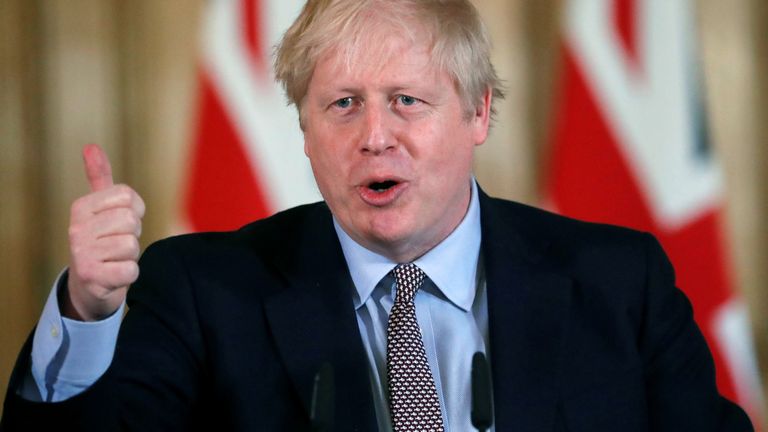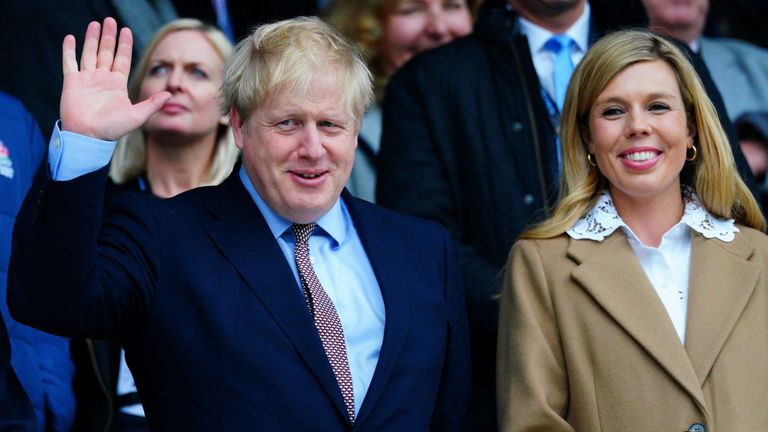Boris Johnson is dramatically returning to the heart of government after his Downing Street comeback, hosting his first coronavirus news conference since his near-death illness.
As well as facing questions about the government's handling of the crisis, it will be his first opportunity to speak publicly about becoming a father again, after his fiancee Carrie Symonds gave birth to a son.
His appearance will come after he chairs a Cabinet meeting for the first time in five weeks and on the deadline day for Health Secretary Matt Hancock's target of 100,000 tests a day.
But the prime minister is expected to dash hopes of major changes to lockdown rules, after shock figures revealed the UK could have one of the world's worst coronavirus death rates.
Any changes are likely to have to wait until the government's scientific advisory panel, Sage, presents evidence to ministers next week ahead of the next lockdown review on 7 May.
Revealing the PM's attendance at the Downing Street news conference, a Number 10 insider said: "He will give an update on the country's fight against this disease and the steps we are taking to defeat it."
The latest figures for the UK, which now include care homes as well as NHS hospitals, show 165,221 cases and 26,097 deaths and reveal that on eight days this month more than 1,000 people died from the virus.
Mr Johnson returned to work in Downing Street on Monday after a week in hospital which included three nights in intensive care, followed by a fortnight convalescing at Chequers with the heavily pregnant Ms Symonds.
At the start of the week, Number 10 said the PM would return to a "normal schedule", which would have almost certainly have included appearing at Prime Minister's Questions had his fiancee not given birth.
But apart from being present for the birth of his son at a London hospital, the prime minister has spent most of the week in meetings with senior ministers, advisers and close aides ahead of the crucial Cabinet meeting.
After the Cabinet meeting, the prime minister will be accompanied at his news conference by the government's chief scientific adviser Sir Patrick Vallance and Professor Chris Whitty, England's chief medical officer.
It will be Mr Johnson's first appearance at the Downing Street coronavirus news conference since 25 March, the day before he announced he was suffering from the virus and the day after he last chaired a Cabinet meeting.
Mr Johnson is expected to spell out why social distancing restrictions must remain largely in place for the time being, despite growing pressure from Tory MPs and business leaders for a relaxation of the rules.
His tough stance follows the disclosure that only the United States, with 60,000 deaths, and Italy, with 28,000, have a higher death toll than the UK and only Spain and Belgium have a worse per-head death rate in Europe.
But he is expected to face tough questions not only on the lockdown but also on the government's record on personal protection equipment for NHS staff and Mr Hancock's pledge of 100,000 tests a day by 30 April.
Announcing his pledge back on 2 April, Mr Hancock said: "I'm now setting the goal of 100,000 tests per day by the end of this month. That is the goal and I'm determined we'll get there."
But critics, including some inside government, claim Mr Hancock is still a long way off his testing target. So far, capacity has reached 73,400 tests and only 52,429 of those tests are being used.
To help plug that gap, Mr Hancock has widened eligibility, including offering a test for anyone living or working at a care home whether they have symptoms or not and all 65-year-olds with symptoms.
But the ambitious testing target is being attacked by NHS and hospital trust bosses, who claim it distracts from shortcomings in the government's long-term coronavirus strategy.
"The recent public focus on whether 100,000 tests will be performed on April 30 is a red herring," said NHS Providers, the body that represents NHS managers.
The report claims the English health and care system "started from a poor position" and struggled to demonstrate a "clear, effective and well-communicated strategy", with a lack of clarity on who would be tested, when, how, and with what frequency.
The report adds: "A vast amount still remains to be done to reach a testing regime that can be described as fit for purpose."
:: Listen to the Daily podcast on Apple Podcasts, Google Podcasts, Spotify, Spreaker
Chris Hopson, NHS Providers chief executive, said: "Testing is one area where, despite all the work delivered by trusts and the NHS, the health and care system as a whole has struggled to develop an effective, co-ordinated approach.
"As we consider the route out of lockdown, what trust leaders need now is clarity on the testing regime from here on.
"Setting a target for a number of tests for April 30 may have had a galvanising effect. But what matters most is an updated strategy to take us through the exit from lockdown."
Responding to the report, a Department of Health and Social Care spokesman said testing was "absolutely critical" and capacity had more than doubled within weeks.
He added: "Our aim as we tackle this virus is to make it easy, fast and simple for any essential worker who needs a test to get a test.
"In addition to setting up a nationwide network of drive in testing sites, we have introduced home testing kit delivery, deployed mobile testing units operated by the Armed Forces, and built three new 'mega labs' to analyse test samples."
https://news.google.com/__i/rss/rd/articles/CBMicGh0dHBzOi8vbmV3cy5za3kuY29tL3N0b3J5L2Nvcm9uYXZpcnVzLWRlYWRsaW5lLWZvci0xMDAtMDAwLXRlc3RzLWEtZGF5LXB1dHMtam9obnNvbi1pbi10aGUtZmlyaW5nLWxpbmUtMTE5ODA4ODfSAXRodHRwczovL25ld3Muc2t5LmNvbS9zdG9yeS9hbXAvY29yb25hdmlydXMtZGVhZGxpbmUtZm9yLTEwMC0wMDAtdGVzdHMtYS1kYXktcHV0cy1qb2huc29uLWluLXRoZS1maXJpbmctbGluZS0xMTk4MDg4Nw?oc=5
2020-04-30 03:42:07Z
52780748466566


Tidak ada komentar:
Posting Komentar